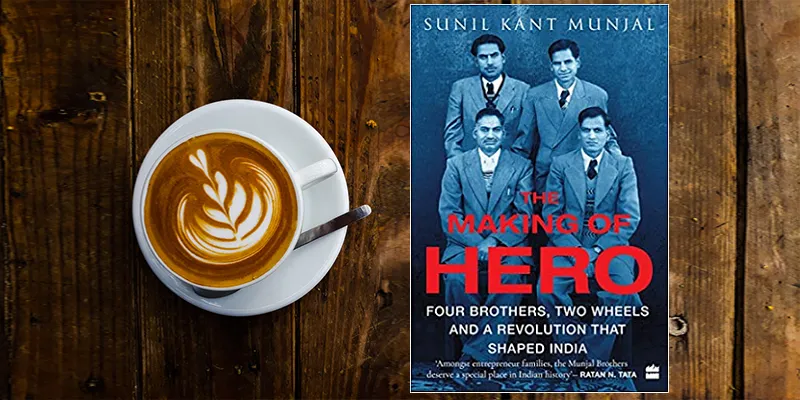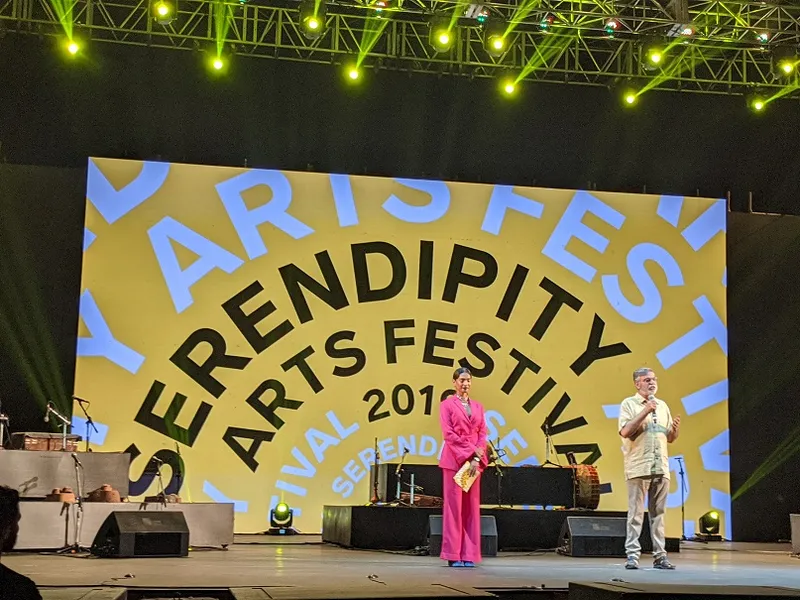From bicycles to billions: The inspiring refugee-entrepreneurs behind the iconic Hero Group
This compelling book on bicycle empire and motorcycle powerhouse Hero Group shares a wealth of stories and business principles on how to succeed in a tough, competitive world.
The saga of the ‘band of brothers’, who withstood challenges, ranging from the Partition crisis in 1947 to the rise of militancy in Punjab in the 80s, is well captured in the new book The Making of Hero: Four Brothers, Two Wheels and a Revolution that Shaped India. Written by the company’s Chairman Sunil Kant Munjal, it documents the journey of the Hero Group.

Starting as traders in bicycle parts, the business family went on to become national leaders in the manufacturing of bicycles. It also expanded into components on the one hand and motorcycles on the other.
In 1986, 30 years after its inception, Hero Cycles became the largest bicycle maker in the world. In the next 15 years, the joint venture Hero Honda also became the largest motorcycle manufacturer in the world. The decades-long story is a salute to the spirit of indigenisation along with global outlook, frugality and ambition, competitive spirit, and collaborative ecosystems.
Sunil Kant Munjal is Chairman of Hero Enterprise, and the youngest son of Brijmohan Lall Munjal, Founder of the Hero Group. He is also the co-founder of BML Munjal University, and sits on the boards of IIM Ahmedabad, International School of Business, University of Tokyo, Escorts, Indian Angels Network Fund, and LIC. He is the Founder of the Serendipity Arts Foundation and the author of All the World is a Stage.
“This book is written in the form of multiple stories that flow into each other,” Sunil begins.
“To dream beyond your means takes imagination and courage,” he adds, charting the growth of the company by leaps and bounds despite the economic constraints of post-independence India.
The threads are interwoven with India’s evolution from post-partition hardships to becoming a global business player. A chronology section listing key dates in the history of the company would have been a welcome addition to the material.
The 12 chapters span 220 pages, and are a mix of storytelling, family saga, and business history. There also 20 pages of photographs reflecting key personalities and milestones.
Here are my takeaways from the book, summarised in the seven sections below.
Early years
The Munjal brothers (Brijmohan, Dayanand, Satyanand, Om Prakash) grew up in Kamalia (now in Pakistan). During the upheaval of partition, they migrated to Amritsar. “Partition left India independent, but in chaos,” Sunil writes on the turbulence of the era.
Some of the family members set up shop in Delhi and Bombay (now Mumbai), before choosing Ludhiana as their base. “The growing market for bicycles and the mechanicals skills of the local artisan community offered potential,” he recalls, describing early opportunities for personal mobility.
Ludhiana was a hub for light engineering (pumps, motors), and the Munjals built their early bicycle business bottom-up. Fortuitously, a saddles supplier named Kareem Deen, who decided to move to Pakistan, passed on his company’s brand name to the Munjals – the name was ‘Hero.’
Having registered in 1956, the early Hero cycle was designed to be a workhorse for the common citizen – rugged, durable, affordable, and with easy access to spare parts and repairs.
Frugal operations and a tight dealer network helped ensure success against competitors like Raleigh and Atlas. Subsequently, better manufacturing technology was acquired from Germany.
Family business
The Munjals, like many a business family, believed in a family that “works together, stays together” (and also lived close to one another). They celebrated family traditions together, and were active at family functions of their senior employees and business partners as well.
Younger members interned at the various group companies, such as bicycle components and ancillaries in the earlier days. Later generations would expand into the IT services business and carbon composites.
In the years 2005-10, the Group put in place a continuity plan for succession. “Forged in times of extreme adversity, during the upheavals of the Partition and post-Partition years, the attachment between the siblings went beyond the usual Punjabi sense of togetherness,” Sunil explains.
The multi-billion dollar group – with 32 businesses – was led by three generations of family members. Fortunately, underlying principles of respect and trust led to a relatively smooth transition plan. This was in stark contrast to much infighting in family firms; 94 percent of family businesses reportedly do not survive beyond the third generation.
National prominence
In the 1970s, the company expanded across India, with businesses in spokes, wheels, and rims. In the later years, it branched out into components for motorcycles and mopeds as well. By 1975, Hero Cycles became the largest manufacturer of bicycles in India; exports began to other emerging economies as well.
That decade, mopeds also made their entry, from companies like Kinetic (Luna) and TVS. The Hero Majestic rolled out in 1975, followed by the Hero Puch in 1988 (with an Austrian partner).
Branding efforts through the decades helped fortify the public perception that the company stood for qualities such as Respect for the Family and The Spirit of India. It was “quintessentially Indian” but with a “modern global mindset.”
A strong brand commands customer loyalty and protection against competition, Sunil explains. This image was fortified through innovative ad campaigns, TV serial sponsorships, and the Hero Cup for cricket.
A customer loyalty programme was rolled out, called Hero Passport Programme (later renamed as GoodLife Programme). Points were awarded for accessory and service purchases as well as referrals. A co-branded credit card with SBI was also launched.
Global partnerships
Early mopeds broke down easily, and not all mechanics could repair them easily. “The great Indian spirit of jugaad could only go so far,” Sunil recalls. Honda, the world’s largest motorcycle manufacturer in 1964, was approached for a partnership.
The deal clicked due to certain similarities in their business practices, such as discipline, dedication, efficiency, customer focus, and dedication to continuous improvement. Hero insisted on four-stroke technology with better fuel efficiency, bigger frames, and larger seats, to meet the needs of Indian consumers.
The agreement for Hero Honda Motors was signed in 1983, with a plant in the region now called NCR. The target customers were aspirational yet frugal. Successfully entering this market would lead to the eventual phasing out of the scooter’s dominance in India, thanks to models like Hero Honda CD 100, Splendor, Passion and Dawn.
The sharp rise of the Japanese yen in the late 1980s led to more indigenisation efforts by Hero, with the expansion of its earlier partners from Ludhiana. The currency crisis of 1991 was followed by the opening up of the Indian economy. This allowed the Hero Group to consolidate and grow further, with new offerings in areas like finance.
In 2010, the Hero-Honda partnership ended, and the companies became competitors. Hero brought in more business practices from US and European companies, thus becoming more global in culture.
Management principles
Even before many modern management principles were coined and written up in business case studies, the Hero Group was practising and living them, Sunil explains. These related to shop floor efficiencies, just-in-time manufacturing, and lean.
Due to its roots in hard business climates, the company had perfected efficient supply chains, concentration and networks of parts manufacturers, and zero-inventory manufacturing.
Mistakes were treated as opportunities to learn, as long as there were no malafide actions or impropriety. Relationships were seen as fair and mutually beneficial, and much more than transactional.
“Leadership was seen as a privilege,” Sunil emphasises. Leaders were expected to be responsible and accountable. Processes were transparent and unethical “inducements” were avoided.
Management was open to ideas, as long as there was proof of concept. There were early fears about job loss due to computerisation, but eventually IT and ERP systems were adopted.
The founding brothers also displayed sensitivity, and had a particular affinity for others who also overcome hardships such as the trauma of Partition. “Success did not dilute their essential humanity or inherent humility,” Sunil proudly says.
The companies were also early adopters of environmentally-friendly practices such as effluent treatment plants and the use of water-based paints. Sustainability was seen as an important part of coexistence in the ecosystem, and not just compliance or competitive advantage.
The group founded the MBL Munjal University in 2014, based on the ‘3 Is’ principles – innovation, inquiry, and impact. There is an emphasis on creativity, entrepreneurship, and industry interfaces.
Social impact
The four elder brothers were supporters of the Arya Samaj movement, with its focus on Vedic essences and rejection of untouchability, child marriage, and bias against women. This led the group to support many initiatives, ranging from setting up schools to volunteering efforts during calamities like earthquakes.
Organisations like Rotary International and the Dayanand Medical College and Hospital were supported. Scholarship programmes for poor students and livelihood training schemes for women were launched.
Cultural contributions
Om Prakash Munjal made early cultural contributions which set the tone for later initiatives. He became reputed for Urdu shayari, and organised a number of mushairas. He published the ‘Hero Diary,’ packed with proverbs and original couplets.
The company’s first annual dealers’ conference in 1968 also featured Bollywood singers such as Asha Bhonsle and Mahendra Kapoor. Over the years, other artists shared the stage, such as Ustad Alla Rakha and Pandit Ravishankar.
“Perhaps that’s how my interest in the arts got triggered,” Sunil recalls; he would later found the Serendipity Arts Foundation (SAF) in 2015. SAF launched the annual Serendipity Arts Festival in Goa in 2016 (see YourStory’s six-part coverage of the 2019 edition here).

Sunil Kant Munjal (R) at the Serendipity Arts Festival
The Ludhiana Sanskritik Samagam was founded to promote art and culture in the city (in 1999). “Responsible businesses are those that give purpose as much weight as the pursuit of profit,” Sunil emphasises.
The book also has elements of humour, such as Brijmohan insisting on being served masala tea instead of green tea by Honda officials on his visit to Japan, or his reluctance in serving alcohol to the Japanese who loved drinks at conferences and meetings.
Unfortunately, in the span of eight months in 2015-16, the last three of the Munjal brothers passed away (another had passed away in 1968). “Partners in life and beyond, they continued their journey together,” Sunil signs off.
The book has received praise from industry heads at the Tata, Bajaj, and Mahindra groups. The Munjals were trailblazers and pioneers, and Brijmohan was like a statesmen, writes Manmohan Singh in the foreword.
The Munjals thrived despite adversity, and Brijmohan throughout remained the “quintessential Punjabi: large-hearted, family-centric and gregarious,” adds Arun Jaitley (who passed away before the book was released).
In sum, this book is a good read for business professionals, academics and entrepreneurs. It is also an instructive lesson for founders and leaders to document the ups and downs of their own journeys so that their hard-earned legacy can be shared with the next generation of nation-builders.
(Edited by Saheli Sen Gupta)









